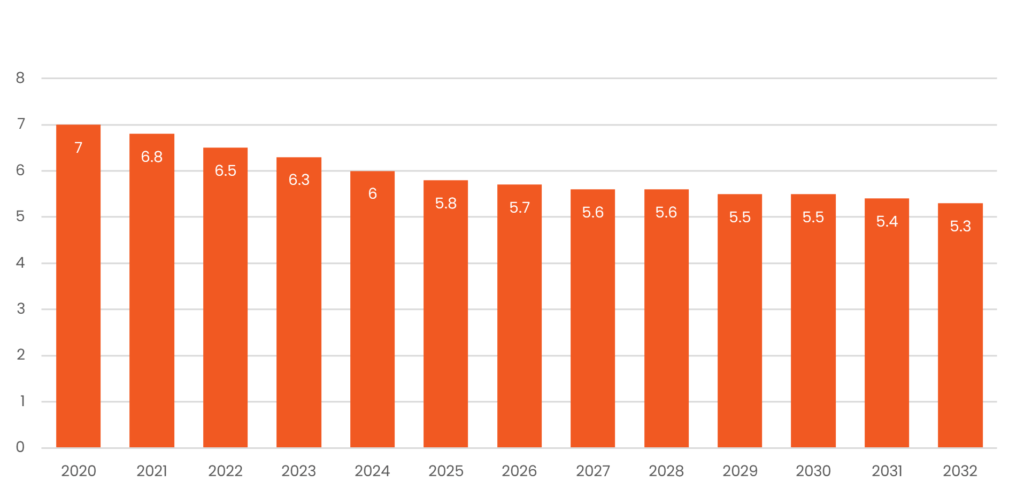Agriculture
Emissions from the agriculture sector cover emissions from livestock, agricultural soils, stationary combustion sources and off-road machinery. Agriculture produces almost a fifth of Scotland’s greenhouse gas emissions. More than 70% of the emissions counted under the agriculture category are to do with rearing livestock.
Emissions fell 9% between 1990 and 2022 primarily due to a reduction in livestock numbers in the early part of that period. Some of the impacts of agriculture on land-use emissions and that of agroforestry appear in the Land Use, Land-use Change and Forestry chapter.
Read this chapter
 Figure 25: emissions in MtCO2e from the agriculture sector 1990-2022, showing a fall of 9%.
Figure 25: emissions in MtCO2e from the agriculture sector 1990-2022, showing a fall of 9%.
The Climate Change Committee recommends that agricultural emissions across the UK need to reduce by 34% by 2035 (from 2019 levels). The proposals for the Agriculture Bill in 2022 translated this into a 31% reduction by 2032, to match the timescale of the current Climate Change Plan and promise proposals for a whole-farm emissions accounting approach in the draft of the next Plan in late 2023.
Around £600 million a year is spent in Scotland on agricultural support, and many farm businesses would not survive without public funding, so public policy has a huge influence over what farming looks like. In 2019 less than 10% of this subsidy was allocated to measures specifically designed to reduce emissions or increase biodiversity.
The support structure which flows from the Agriculture and Rural Communities (Scotland) Act 2024 represents the perfect opportunity to realign policy for a sector which is responsible for nearly a fifth of Scottish emissions, and to encourage climate and nature-friendly farming. If agriculture and land use fail to reach their respective targets, Scotland will fail to reach its national targets too.
The revised agricultural support regime must include payments to farmers, crofters and land managers to support delivery of national climate change emission reduction objectives, to support delivery of national climate change adaptation objectives, and to support integrated land management, such as for peatland and woodland outcomes on agricultural holdings. Some payment will be conditional on outcomes that deliver on climate change.
Farming is the least diverse sector in the UK when it comes to ethnic diversity. Any new job creation in the sector should actively aim to tackle racial inequality.
Some policies in this chapter come from the Farming for 1.5º group – an independent inquiry on farming and climate change in Scotland, co-ordinated by NFU Scotland and Nourish Scotland. It involved a panel of farmers, NGOs and scientists, and the main report in 2021 looked at pathways to 2032 and then to 2045.
Agriculture emissions 2020-2032 (MtCO2e)

Expected climate change emissions from agriculture 2020-2032
The Climate Change Plan update lists six outcomes in agriculture, along with the policies and proposed policies supposed to deliver them.
Outcome 1: A more productive, sustainable agriculture sector that significantly contributes towards delivering Scotland’s climate change, and wider environmental, outcomes through an increased uptake of climate mitigation measures by farmers, crofters, land managers and other primary food producers
Outcome 2: More farmers, crofters, land managers and other primary food producers are aware of the benefits and practicalities of cost effective climate mitigation measures
Outcome 3: Nitrogen emissions, including from nitrogen fertiliser, will have fallen through a combination of improved understanding, efficiencies and improved soil condition
Outcome 4: Reduced emissions from red meat and dairy through improved emissions intensity
Outcome 5: Reduced emissions from the use and storage of manure and slurry
Outcome 6: Carbon sequestration and existing carbon stores on agricultural land have helped to increase and maintain our carbon sink

